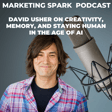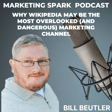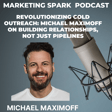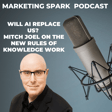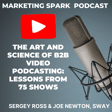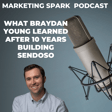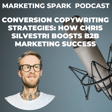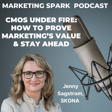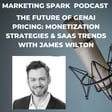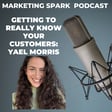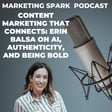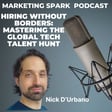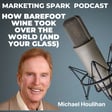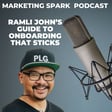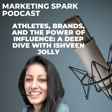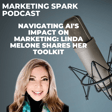Become a Creator today!Start creating today - Share your story with the world!
Start for free
00:00:00
00:00:01

Turning Up the Volume on Conversational Marketing
For many B2B SaaS companies, conversations are the ultimate success metric.
When customers directly engage with you, relationships are established and, as important, the sales journey is jump-started.
On this episode of Marketing Spark, Mark Kilens, Drfit's VP of Content & Community, talks about how conversation marketing gained momentum last year at a time when conferences disappeared.
Drift pioneered conversation marketing with the introduction of an AI-powered chatbot that attempts to engage, understand and recommend solutions.
Mark and I also talk about Drift's approach to content marketing, the importance of content distribution, and some of the metrics used to assess content marketing success.
Transcript
Introduction to Marketing Spark and Mark Killens
00:00:05
Speaker
Hi, it's Mark Evans, and you're listening to Marketing Spark, a podcast that features conversations with marketers and entrepreneurs in the trenches. As a B2B SaaS marketer, I'm surrounded by customer metrics, MQLs, SQL, conversion ratios, and click-through rates. At the end of the day, I'm a big believer in conversations. A lot of business happens because you've connected with customers about their needs, interests, and goals. And when that happens, sales are a lot easier and faster.
00:00:36
Speaker
On today's podcast, I'm talking with Mark Killens, VP content and community at Drift, the pioneer and leader in conversational marketing. Welcome to Marketing Spark, Mark. Thank you, Mark.
What is Conversational Marketing?
00:00:48
Speaker
Great to be with you today. Let's start by defining conversational marketing. What is it? What makes it so effective?
00:00:57
Speaker
Yeah, start at the top. I mean, conversational marketing was something that Drift created back in 2016. It's been around for a long time and has really gained a lot of traction. Conversational marketing allows you to engage instantly in a very hyper-personalized way with your customers and buyers.
00:01:18
Speaker
to ultimately create more pipeline and accelerate revenue. The key to it though is it's in service of creating a better buying experience, a better digital buying experience with that notion of personalized messaging, personalized help, personalized assistance, if you will, to guide you through the buying process.
00:01:40
Speaker
So how does conversational marketing happen? I mean, obviously there are chat bots, there are conversations, believe it or not, with real people. Maybe you can define the different ways that conversational marketing happens in the wild. It's another good question. I mean, we took a very hard look at
00:01:59
Speaker
What is the structure of a conversation? And we boiled it down to three things. And these three things really guide a lot of how we build product at Drift, how we teach people to use conversational marketing and sales. What we call this is the conversational framework. And it's three pieces, engage, understand, recommend.
00:02:20
Speaker
So how do you engage one of your buyers or customers, like I said, in a very relevant, contextual, personalized way when they come to your website? We can unpack that if you want. How do you then understand a bit more about them in the traditional sense of marketing?
00:02:37
Speaker
It's like qualification or disqualification, but it's really understanding more about their intent, their motivations, who they are, how are they feeling
Challenges and Benefits of Conversational Marketing
00:02:45
Speaker
that day, all of those kind of signals. And you, at the same time, through a conversation, either with a chatbot, an AI virtual assistant, or another human being, live chat,
00:02:57
Speaker
are helping maybe them understand a bit more about your business or what you can offer them in that moment, just like a natural conversation would occur. And then there's ultimately like a recommendation and there might be multiple recommendations through a conversation, but in a lot of these interactions with conversational marketing,
00:03:16
Speaker
They don't last too, too long. So the the recommendation typically is at the end of the conversation. At least, you know, it's like from a marketing perspective, it's like a call to action, if you will. It's like, what's the next best action we can help this person who's visiting our website, looking at something?
00:03:34
Speaker
What's the next best action? Is it to maybe go to someone on the sales team? Is it some more marketing type content? Is it a support or service type inquiry? How can we recommend and guide them to the next best thing? So if you think about it, just engage, understand, recommend the power in that framework. That's the genesis of all things conversational marketing and sales.
00:03:56
Speaker
I love that framework of love the simplicity and the fact that it really it. Identifies the key pillars when it comes to the customer journey and i'd like to circle back a little bit to engage because in my business i position myself as someone who helps bdb sass companies attract and engage but the reality is.
00:04:14
Speaker
Engaging consumers these days is extremely hard. I mean, there's a study that suggests that they see 100,000 words or audio or ads or social media a day. So there's so much information coming at them that for a marketer, it's a huge challenge trying to get someone to stop even for a short period of time. Can you elaborate on the link between conversational marketing and engage? Now, how do they work together? How do they allow companies to really
00:04:44
Speaker
Pull in a customer so you can start a conversation and get them down the buyers journey. I mean to me like in the way we think about drift marketing these days is a function of building a relationship.
00:05:00
Speaker
and building a strong trust bond, if you will. I think of it almost as a chain. There's links in a chain. And what marketers should be trying to do is add more links to that trust chain. And it's a sensitive chain. It can break it almost any time with really one bad engagement or interaction. So from an engagement standpoint, what conversational marketing tries to do is it tries to not only empower the marketer and the salesperson, but the visitor
00:05:29
Speaker
To give them the power to to give them the power of the buying process that they want to go through right like they most people and some of this comes from our state of conversational marketing survey that will talk I'm sure more about some of this comes from Gartner or Forrester There's many more people these days that really don't want to talk to sales per se no marketing and sales are some of the least trusted and
00:05:52
Speaker
you know, jobs, right out there. So it's even more important to the common image just a minute ago, like about the trust chain and how you build that. So from an engagement standpoint, it's like, how do you make that experience
00:06:05
Speaker
Typically, the digital side of the experience feel as relevant and as helpful to each buyer. So from a marketer's perspective, it's flipping the idea of your website to be very buyer-centric and understand who's coming to the website. Conversation marketing helps you understand who comes to the website, where are they coming from, and where are they in the purchase
00:06:32
Speaker
journey, the buying journey, or the customer experience journey, however you want to frame it. So where are they in that? And then what page are they on? So if you take those three, those technically four things, but it's the who, the where, and the what, that's going to help you then start to shape out, how do you best engage with this person? But then a second thing has to happen as well. What our most successful customers do, customers like Adobe, Okta, etc.
00:06:57
Speaker
Also then make sure that when one of those visitors comes to the website that we know is either in market or is out of market but qualified, but might not be showing really, really high levels of intent, they're still going to notify the sales owner, the account owner at the company of that visitor, of that visit. And it's on then the salesperson to be enabled to know what to do in that situation. If they're free, should they try to kind of jump into that interaction and engagement and reach out in a really human personalized way?
00:07:26
Speaker
Should they follow up the next day? Should they follow up in five minutes? So it's doing not only the front-end change management of what they experience on the website from an engagement standpoint, but it's also making sure the backend workflows of how you get your sales team now involved in these conversations.
00:07:42
Speaker
That's the key mark. It's both sides of that coin. The other angle that I want to ask you about is the fact that I think it's Gartner suggests that a customer has done about, it's about 70% down the path, down the buyer's path before they even touch a company. And they've done their research. They've looked at other websites. They've looked at analyst research. They've checked out Capetaro or G2. So they're armed with a lot of information.
00:08:10
Speaker
So by the time they hit the website, they're looking for something else or looking for some, looking for engagement or something personal and relevant. I guess that's where conversational marketing can really fill the gap. That final 30% that you need a customer to get before they make the purchase.
Customer Journey and Research
00:08:25
Speaker
You make a great point. I say it like this, conversational marketing and sales helps the empowered buyer buy. In a nutshell, that's a great way to explain the experience for sure. 100%. Before we move on, I did want to ask you a little bit about Drift. I mean, this is a company that has had tremendous growth, enjoys a very high profile.
00:08:46
Speaker
As I said off the top, they're the pioneers in conversational marketing. How did it get to where it is today? Like what was that moment where the company realized that conversational marketing was the path to success and provide a little bit like how did the company start? What was the original mandate?
00:09:01
Speaker
Yeah, the company started way back in 2014, 2015. Those are the founding years. David, Cansell, and Elias Torres, that's when they started it. It was not originally conceived as like, oh, conversational marketing. What David and Elias, they're brilliant in many things, but what they're so good at is obsessing over learning from the customer. And we actually have a leadership principle, one of our eight at Drift, that is,
00:09:28
Speaker
that is called put the customer at the center of everything you do. So they just take from a product development standpoint, so first like product market fit, then eventually like go to market fit, but if you talk about product market fit, they take this lens of like let's learn through quick feedback loops from customers using these different ideas we're spinning up and turning into something usable from a software standpoint and see what sticks. So they went through a few iterations,
00:09:56
Speaker
It started as almost like an HR thing at one point. There was like an annotate tool for like your iPhone app. There's a little we call annotate, I think. I used it for a little bit. Then they started to realize that messaging. So what they're also really great at, and what we do at Drift is we look at the trends that are outside of almost anyone's control. It's like, what's changed in human behavior? What's changed in how we buy, how we live, et cetera? And how do then do those things apply in the context of B2B?
00:10:25
Speaker
So there were some massive trends happening, right? The rise of mobile, that's been a trend over the last 15 years. The rise of mobile really then finally allowed the rise of messaging to occur. I mean, I was using AOL instant messaging, Mark, you know, I'm sure you'd use the hashtag, you're smiling way back in the day, but like, it wasn't really, you know, in a everyday way you could use it, you had to go to your computer, sit down, like it was like, you know, you had to beat your house.
00:10:49
Speaker
Because of mobile, because then messaging platforms and technology tools were built on top of mobile, it's like, wait a minute, there's a whole new communication paradigm. So that's almost the genesis of conversational marketing and sales where it's like everything now is becoming that much more conversational through the power of these digital technologies and digital platforms. And now businesses need to adapt to that because that's how humans are communicating.
Impact of the Pandemic on Marketing Strategies
00:11:12
Speaker
So that was really the starting point. I'll pause there though.
00:11:15
Speaker
Drift alongside Heinz Marketing did a survey that talked to more than 500 marketers for their insights on conversational marketing. Talk about the highlights, some of the things that marketers told you, some of the things that were surprising when you talk to these 500 marketers.
00:11:33
Speaker
One of the things that we've seen, and we've done the survey now for three years, so we actually have three years of data. It's really interesting to see how it's trending in these different directions. We're seeing more and more companies adopt conversational marketing solutions, number one. And I really think this pandemic that we've had to live through, unfortunately, was a trigger point, trigger event.
00:11:58
Speaker
for more and more businesses to use something like conversational marketing and sales, because they almost had no choice to. So one of the stats was we asked a question around AI-powered conversational marketing, making it more accessible and more invaluable than ever before. How do you feel about that? 82%, 4% to 5% people are finding that type of solution, an AI-powered conversational marketing solution, to be very valuable to their sales and marketing strategy.
00:12:27
Speaker
So that's pretty significant. That's gone up a decent amount. And what's also interesting, we talked about engagement. About 45% of the people surveyed, and this was like 500 people in this latest survey. It's a pretty big sample size.
00:12:43
Speaker
their engagement rates increased over the last 18 months in the pandemic. So more people are engaging through this digital buying experience. So how do you personalize this digital buying experience? How do you make your marketing and sales funnel, if you will, more buyer-centric? What we're seeing through this data is more and more people are adopting conversational marketing and then conversational selling.
00:13:05
Speaker
to do just that. And what's interesting is also is like buyer's expectations. So we ask questions to this audience about like the actual solution, the technology, those things, but then how do you buy as B2B buyers? So we looked at kind of both sides of this coin and the expectations around quick and personalized experiences from these B2B buyers, mostly managers, directors and above, those experiences and whatnot,
00:13:32
Speaker
have grown by 26%, meaning they expect more of them by 26% year over year. And an immediate response, so when you're actually reaching out to a vendor, to your point on the 70% mark, when you're finally ready to talk to a vendor, this is the last interesting stat that I'll share right now.
00:13:48
Speaker
The immediate response has grown 64% year over year. So more and more of these B2B buyers and decision makers are expecting immediacy, instant response when it comes to reaching out to a vendor. And if you don't have that, guess what's going to happen most likely? They're going to probably go to one of your competitors or they'll look the other way, right? Attention spans to your point.
00:14:06
Speaker
I don't know if you asked this question, but I am curious about the disappearance of conferences and the impact that it had on conversational marketing. When you think about it, many B2B companies spent 50, 60, 70% of their marketing budgets going to conferences. Why? Because they wanted to have conversations with prospects and customers. It was the way that
00:14:28
Speaker
It was an easy way for marketers to drive MQLs. The sales guys could nurture leads, could connect with customers and drive loyalty and as important upsells. So what do you think the impact or the correlation was between the decline in conferences, and they may come back soon or not, and the rise in conversational marketing?
00:14:51
Speaker
It's a great question. We've pivoted all of our events to be virtual. We're going to be back in person finally next year. But what we've done is we've integrated with some systems like ON24, another up-and-coming event platform called Goldcast, and put the conversational experience in front of that. So you can make the actual event experience more conversational.
00:15:12
Speaker
But before you even get them to the event, what marketers have had to do is pivot their channel mix. To your point, like an event is kind of like a channel, right? That's where you can reach people. Now the channels are going to be much or have been, excuse me, much more like digital based. So we see our customers using conversational marketing.
00:15:29
Speaker
within their paid search and social strategy, within their organic search strategy, within their email strategy. Those are some great ways you can pair up because you know where the visitor's coming from. You know they're coming from organic search. You know they're coming from an email. You know they're coming from an exact paid ad. And then you can serve up this really contextually rich conversational experience on your website page based off of, again, like we said in the beginning of this podcast, who's coming to that page?
00:15:58
Speaker
where are they coming from, email, pay that, organic, etc. And then what are they engaging with? In this case, your questions around they're engaging with an event. Are they looking to sign up for the event? Are they looking to get more information about it? Are they looking for the recording? You can make it super easy to help them
00:16:15
Speaker
find and do exactly what they're looking for with that event. And then furthermore, what the beauty of all this stuff is your sales team. We've empowered in the sellers to say, Hey, here's all of the people that you normally would have seen at this event coming to our website, signing up for the event, attending the event. Here's what they did during the event and giving them
00:16:34
Speaker
again, those kind of behavior signals or signals of intent, and being able to still continue the buying help the buyer buy through those through those data points versus the in person piece. I mean, so I think I think it's a combination of both in the future, but it's really making sure that you can provide people who keep going back to this real time idea, Mark, the real time insights into what your buyers are doing. But I think the question I was asking was that when
00:16:59
Speaker
In person events disappeared conversations disappeared opportunities to have relevant contextual real time conversation disappeared and. I guess the answer i'm looking for the conversational marketing fill the gap companies need those interactions they need conversations and did they turn to conversational marketing last year.
00:17:18
Speaker
Well, I think they did turn to conversational marketing. That's what the study said. But as a marketer, you don't turn to the solution. You follow the buyer. The buyers shifted how they engage with companies. Instead of going to these events, like I was saying, they shifted to digital channels, digital virtual events, and whatnot. And you can use conversational marketing in those channels, with those channels, to
00:17:41
Speaker
create better engagement, create better experiences. So the short of the answer is 100% yes. But I think the best companies and now what most companies are doing is saying, Oh, well, where have my buyers gone? You know, because there's no events and how can I meet them where they are with conversational marketing.
Evolution of Content Marketing at Drift
00:17:57
Speaker
Let's shift gears a little bit and talk about Drift's approach to content marketing. As the VP of content and community, I'm sure you got a lot to say. First, I'm interested in how Drift's content marketing or its approach to content marketing has evolved over the past 18 months. To me, content has always been king, but there has been no doubt that content has really stepped up as things like conferences haven't happened. Can you provide a little bit of context in terms of how Drift's approach to content has changed?
00:18:27
Speaker
Yes, it's a timely question because I actually posted something today on LinkedIn today being the end of October. I think it's actually October 27th for those interested in when we recorded this.
00:18:37
Speaker
I posted something on LinkedIn that comes from, we love research, original research at Drift. We find it very insightful. So we did another survey to about 100, I think it was 115 marketing leaders, the vast majority of those people being director and above B2B marketing leaders. So VP, CMOs, director level. And the number one most important thing they say is,
00:19:04
Speaker
they say in the next five years that they're really focused on is content marketing. 53% said that, so half of it. And they've actually found that content marketing, as it relates to pipeline generation and the impact on it, went from number seven on the list last year to this year when we did the survey, it was number one.
00:19:22
Speaker
So again, I think it's this event that happened with this pandemic and it's made people realize, well, we need to be more helpful than ever on the digital side of things. We need to stand out somehow. We can't reach people in person. We can't go to the events. We can't go to the dinners. We can't do these field events. We can't do all these things. So how are we going to really, really stand out? And honestly, content marketing is a differentiator for the brand. So we
00:19:44
Speaker
We just doubled down on it. We were always very heavy in the content marketing space. You know, I have a deep background in content. I was at HubSpot for eight and a half years. So I know content pretty well. And Drift also started their brand as a very
00:19:59
Speaker
powerful, from a very powerful content marketing standpoint. What I mean by that is early days, what Drifted, David Cansell, and in this case, Dave Gearhart, started what I call a great cornerstone content asset in the form of a podcast. It's named Seeking Wisdom. And that was really one of the ways that also helped us not only grow the Drift brand and make it stand out and make it unique, but it also helped to bring conversational marketing to the world through that podcast.
00:20:26
Speaker
We wrote a book on the category, Conversational Marketing. There's a whole book on it, a best-selling business book on it. We wrote many books, This Won't Scale, as an example. All these different, dozens of different ways of how to do marketing that doesn't technically scale but has really strong ROI. So I think our content game's always been strong. Now it's about, though, really making sure you're smart with your content and understanding the spend to impact of your content. So understanding all this time and money and effort you're putting into your content,
00:20:53
Speaker
How is it really turning into the right leads, but really the right pipeline for your business? And how are you using content more and more than ever before to drive customer success?
Ensuring Consistency Across Customer Touchpoints
00:21:03
Speaker
So we have a full lifecycle content team here, Mark. And we have three overall content teams, four maybe, but three that focus on the content across the entire customer experience. So pre and post. So that's another thing I think businesses have started to shift to as well during the pandemic. How do you make sure the content is consistent across all the touch points?
00:21:23
Speaker
What has surprised you and drift in terms of how and where people are consuming content linked in for example has emerged as a Great place to to get insight from lots of different kinds of people, but are there other? platforms or other ways in which content has been delivered that caught you by surprised or emerged faster than you expected and
00:21:50
Speaker
To me, live streaming is super interesting. I mean, a lot of these platforms have added live streaming, right? Like LinkedIn live, Instagram. I mean, everyone now has a live streaming component. And a lot of that has been born out of the gaming space. Now there's like live stream, like online shopping, that's taken from like the TV world, right? Like the almost like the live infomercial, if you will. The live component of content is super fascinating. And a lot of people think, well, like,
00:22:20
Speaker
is like, as a webinar content, I'm like, heck yeah, that is content. An event at the end of the day is two things. It's like great content, hopefully it's great content, and it's a networking experience, right? If it's more in person, right? But from a virtual standpoint,
00:22:36
Speaker
Your virtual event over the last 18 months really has hinged on your ability to create differentiated and highly valuable content for the audience. So that's another reason why I think everyone is doubling down on this and realizing if we did do this right and we really have a unique brand voice, we have a unique point of view in the market, we have some thought leadership, doesn't have to be crazy thought leadership, but we have
00:22:56
Speaker
something that is uniquely different. We can use this as a competitive advantage for our business and we can really use this not only across marketing but in sales and CS to add additional value to the actual product we sell. And you can charge a premium then, right? And you're a premium brand in that case. And that's where content has this effect, I think.
00:23:18
Speaker
On one of my recent podcasts, I talked to Ross Simmons, who's a very well-known B2B content marketer. The thing that he talks about is not just content production, but distribution and repurposing content to maximize ROI. What is Drift's approach to those two content pillars?
Content Repurposing and Measurement at Drift
00:23:37
Speaker
I actually have a whole framework called the content repurposing framework. Literally, I have this completely laid out for my team. We use it all the time. It's four different hours. It's reuse, refresh, repackage, reposition. So reuse, refresh, repackage, reposition. All of your content assets, especially your cornerstone content assets. And there's technically, in my opinion, five, maybe six cornerstone content assets that at least we definitely create a drift.
00:24:05
Speaker
We take that into consideration. We do quarterly planning at Drift. We have this notion of integrated campaigns that we run, really focused on the audience, the trigger event, what are the goals of the campaign, and then the highest level messaging. And then we map out offers by channel.
00:24:20
Speaker
to get that content, to get that great information out into the market. So Ross's point and your point is extremely important, right? It's like, yeah, you can plan your content, you can produce your content, but if you don't think about promoting your content, with deep collaboration with your demand gen or in our case, revenue marketing team, you're missing a significant part of the content marketing game. So yeah, we have these four R's and we use it all the time. It's how you atomize, we kind of call it the solar system strategy. Absolutely.
00:24:49
Speaker
Here's a tough question. How does drift quantify the success of content marketing? Cause obviously there's, there's the standard KPIs and metrics that marketers and sales teams use. And then there's this whole dark social phenomenon that a lot of people are talking about. So when you look at the success of your content marketing efforts, how do you tell whether you're being super successful? How do you tell what's do what you're doing well and what's not working? What are the different elements that you look at?
00:25:18
Speaker
It's a really good question. It's something that's asked a lot. There's two ways at the highest level to think about it. Engagement and pipeline. And then what you look in the middle, and I can get into details of all of these things, but I'll just keep it simple to start with. Engagement and pipeline. And what's in the middle of those two things is how many of those engagements and an engagement could be
00:25:37
Speaker
a download of a book, a website session, a social media engagement. We have literally 80 or 90 different types of engagements that we measure across our content and community team. How many of those engagements, and some of them you can't identify here, but how many of those engagements that you can identify fit into your ideal customer profile basically are a quality engagement.
00:26:01
Speaker
So then you get into the nuance of what type of model you're using, first touch, last touch, multi-touch attribution. We have a multi-touch attribution model that looks at a more tops down view of that model. We also have a bottoms up model. But ours right now is more multi-touch attribution. There's no perfect way to go with that to your point. You just got to pick one and stick with it for a little bit and figure it out. But the other thing that I think Content Market has failed to measure when it comes from a content standpoint is how is your sales team and CS team using your content?
00:26:29
Speaker
So we have a solution called High Spot. And so we actually see, on a weekly basis, we have about 3,000 engagements with our content from our sales and CST members in High Spot. That's like 12,000 a month. That's awesome. That means they're using this content to help people buy and learn more about Drift and be successful with Drift. And ultimately, what you want to see is your engagement is growing quarter over quarter, year over year. And then therefore, if you have your revenue and demand stuff dialed in enough,
00:26:59
Speaker
That should follow suit in many ways. A final question.
Leveraging Executive Content for Amplified Reach
00:27:03
Speaker
David counsel obviously has a very high profile and he creates a lot of great content, including the podcast. As you mentioned, how does drift leverage David? How does he manage his time in terms of creating high value content at a time when obviously he's, he has other priorities and he stretched in different directions. You know, what's your strategy, your content strategy when it comes to David?
00:27:26
Speaker
I mean, David in many ways is like the quasi chief marketing officer, if you will.
00:27:33
Speaker
the chief salesperson, the chief marketing officer. You know what I mean? They're selling the business. So we do as much as we can to support him in that endeavor. So just as an example, there's a big web summit happening in Portugal, early November, next week it is. He's going to be speaking on that, right, at that. So if my team helped him and someone on our communications team,
00:27:56
Speaker
build his presentation. And then what are we going to do with that? We're going to repurpose it, repackage it. So that's an example. We have someone who does ghostwriting to help him take his ideas and really scale them out. So I think that's really important. Many companies do that. If you don't do that for your executives now, I think you should 100% have someone that helps them write.
00:28:16
Speaker
They have amazing ideas are brilliant people in many ways and there's something to be said that a content marketers job it might not be the best term but you're almost acting as a broker. You're helping take someone's ideas and wisdom and knowledge and experiences.
00:28:32
Speaker
and share them with someone else. That's why I see it not just for David, but Elias. Elias has this American Dream podcast and American Dream newsletter. I see that with Katie or CMO. I see it with anyone who doesn't even have to be executive level. People at Drift contribute to our content and our customers contribute to our content all the time. That's what a great content marketer does. They actually don't create a lot of the original content. They help in the facilitation of bringing those other people along and helping them share what they know and getting it into the right hands.
00:29:01
Speaker
One tactical question when it comes to pulling content out of an executive like David, is it a matter of sitting down with him for half an hour or an hour and saying, what are you thinking? What are your big ideas? What kind of opinions do you have? Where do you think the industry is going and simply recording his conversations and then repackaging them in a blog post?
00:29:22
Speaker
or an ebook or some kind of content asset. Is it as simple as that? They tell you what they want to say and they say it. So you just package it up properly. Is that is that a simple way of doing things? One way of doing things. It can be what we found to be even more successful. I've seen this at both Drift and HubSpot is get give them something to react to.
00:29:43
Speaker
And then you can ask them some questions about that, but give them something to react to, and then maybe you have to come back with something else then, and then that's the basis for the content and the questions and what they're going to share with you. But that's the tactical thing, I think. Give them something. And also, in our case, we're really leaning hard into the whole conversational space, conversational marketing sales, conversational commerce even.
00:30:08
Speaker
The leader of the business is going to have to be the person who really sells the vision and sells what makes your company uniquely different.
Exploring More at Drift.com
00:30:18
Speaker
How do you then organize that within a campaign across your marketing team? A tactical thing also is have a campaign
00:30:27
Speaker
We use briefs, how a campaign level brief that then can take all the stuff that your executives are saying, in our case, David, and use it across these different channels. So again, to your point about promotion, think about the whole journey in what you're doing with your executive. Don't think just LinkedIn. Yeah, he's got LinkedIn strategy, does things on Twitter. But he's got a newsletter that we do every Saturday called The One Thing. We've branded that. We use a lot of his Seeking Wisdom podcast content still.
00:30:54
Speaker
I think you gotta take, you gotta be tactical in how you approach it, but you also have to create a plan. Final question, where can people learn more about you and Drift?
00:31:03
Speaker
I mean drift.com, drift.com, a drift insider. We like to think of it as like the number one place marketers and salespeople can go to learn. It's a free community. We have a ton of, almost everything's not gated. You gotta sign up for an account to get some of our more exclusive content, some of our more in-depth courses and classes, but it's all free. Drift Insider, drift.com slash insider. And then yeah, you can just follow me on LinkedIn, Twitter, you can text me. I got my phone number, 978-226-6965.
00:31:33
Speaker
And you can't call that number, it's only for texting, conversations after all, right, and messaging, but shoot me a text, happy to talk to you. Thanks to everyone for listening to another episode of Marketing Spark.
00:31:44
Speaker
If you enjoyed the conversation, please leave a review, subscribe via iTunes and Spotify, or your favorite podcast app, and share via social media. To learn more about how I help B2B SaaS companies as a fractional CMO, strategic advisor and coach, send an email to mark at marketingspark.co or connect with me on LinkedIn. I'll talk to you next time.
